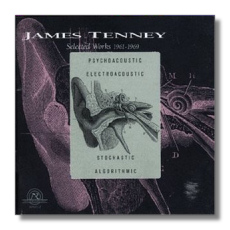
The Internet's Premier Classical Music Source
Related Links
- Latest Reviews
- More Reviews
-
By Composer
-
Collections
DVD & Blu-ray
Books
Concert Reviews
Articles/Interviews
Software
Audio
Search Amazon
Recommended Links
Site News
 CD Review
CD Review
James Tenney

Selected Works, 1961-1969
- Collage #1 ("Blue Suede")
- Analog #1 ("Noise Study")
- Dialogue
- Phases (for Edgard Varèse)
- Music for Player Piano
- Ergodos II (for John Cage)
- Fabric for Ché
- For Ann (rising)
James Tenney, electronics, player piano
New World 80570-2 ADD 70:37
Tenney, anyone? In 1992, the obscure Frog Peak/Artifact label released a CD compilation of early works by American composer James Tenney, a pioneer in the field of computer music. That CD went out of print, but now it has been reissued by New World Records with expanded booklet notes by fellow composer Larry Polansky.
Perhaps the best place to start is at the end, with For Ann (rising). Like an Escher print, this is music that seems to ascend infinitely over a nearly twelve-minute span. Tenney accomplishes this auditory illusion by layering more than a dozen out of phase glissandos one of top of the other. The ear tricks itself into seamlessly jumping from one glissando to the next when it can no longer follow the first one. The work is based on what is known as the "Shepard-tone," named for experimental psychologist R. N. Shepard. Paying close attention to For Ann (rising) can create disorientation in the listener, as he realizes that what he thinks he is hearing is not logically possible.
Another Tenney "greatest hit" is Collage #1 ("Blue Suede"). As its name suggests, it is based on Elvis Presley's recording of the Carl Perkins song. Also, it really is a collage… a collage of tape-manipulated Presleyana, if you will. Tenney slows it down, speeds it up, filters it, plays it backwards, and slices and dices it. At first one can't make out the source material, but within less than a minute, shards of Elvis's voice emerge, albeit an Elvis who seems to be speaking in tongues. Tenney's aggressive editing preserves the grungy feel of rock and roll even as it affectionately perverts the work of one of its saints.
Conlon Nancarrow's hegemony over the player piano as an avant-garde instrument is challenged by Music for Player Piano. (Tenney, it should be noted, was hardly aware of Nancarrow's existence at the time he wrote it.) Unlike Nancarrow, however, Tenney relied on computers to compose this work. The longest work on this CD – more than eighteen minutes long – is Ergodos II (for John Cage). "Ergodic," according to Webster's Ninth New Collegiate Dictionary, is "of or relating to a process in which every sequence or sizable sample is equally representative of the whole (as in regard to a statistical parameter)." This relates Tenney's piece to so-called "process music" and to aspects of Minimalism. Tenney defined the variables and algorithms, and, one might say, left the music to compose itself. This is no way diminishes Tenney's achievement, as Ergodos II (for John Cage) is both unique and aurally provocative, as the ear struggles to find the music's form.
Obviously this CD will appeal to a specialized audience, but if you've read this far, you probably know and care about Tenney's work, so let me close by saying that New World has done a bang-up job in preserving this material for the benefit of older listeners, and of introducing it to newer ones.
Copyright © 2003, Raymond Tuttle


















